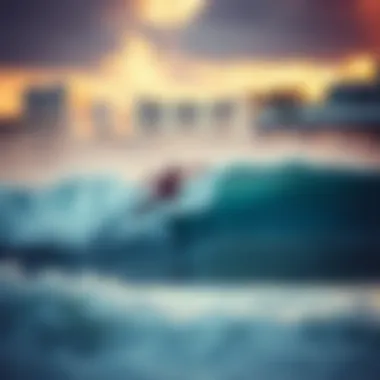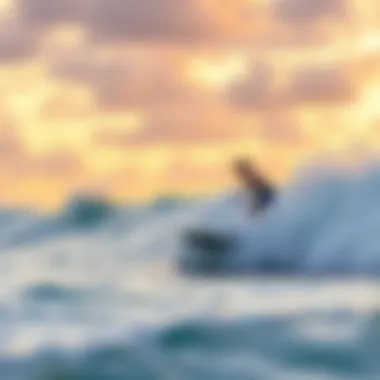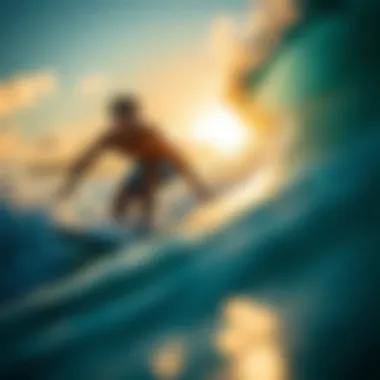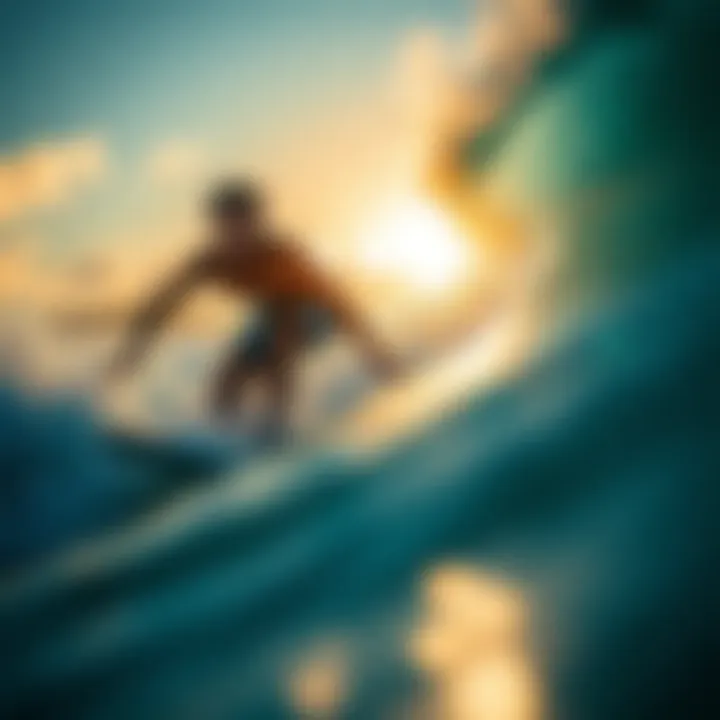Mastering the Waves: Surfing at Cocoa Beach


Intro
Learning to surf is like trying to learn a dance with the ocean. At Cocoa Beach, the vibrant surf culture and community add layers of meaning to each wave, making this location a perfect starting point. Yet, before one rides their first wave, it’s essential to grasp the fundamentals, ensuring both competence and safety. So here's what to consider as you set forth on this exhilarating journey.
Situated along Florida's Space Coast, Cocoa Beach offers a unique surfing experience. Known for its consistent swells and a friendly atmosphere, beginners feel welcomed while advanced surfers find challenges in the waves. But there’s more. Understanding how the surf breaks work, what equipment you need, and how to respect the local surfing community are key aspects of becoming a proficient surfer.
This guide aims to break down the essential techniques, equipment choices, and environment considerations that every surfer should know. Whether you’re just dipping your toes into the world of surfing or have plans to sharpen your skills, this resource endeavors to serve surfers, travelers, outdoor enthusiasts, sports coaches, and fitness professionals alike.
Let’s dive into the core elements of surfing at Cocoa Beach, starting with Surfing Techniques, which will cover everything from beginner tips to advanced tricks.
Intro to Surfing
Surfing is not just a sport; it’s a way of life for many individuals who find solace, excitement, and connection with nature through these waves. As we delve into this guide about learning to surf, it's essential to appreciate the introductory elements of surfing that set the stage for anyone looking to catch their first wave. Understanding the historical context and cultural significance enriches one's experience and fosters respect for both the sport and the environment it thrives in.
Historical Overview of Surfing
Surfing traces its roots back centuries, with its origins primarily linked to the Polynesians, who surfed on wooden boards made from local trees. It wasn’t merely an activity but a pivotal part of their culture, symbolizing strength, skill, and a connection to the ocean. In the 19th century, surfing found its way to the mainland United States, specifically California, where it blossomed into a mainstream pastime. Notable figures like Duke Kahanamoku became synonymous with the sport, bringing it into the limelight and influencing generations to embrace the power of riding waves.
The evolution of surfing is marked by a transition in equipment as well; the materials and shapes of surfboards have drastically changed over the decades. From the heavy wooden boards of the past to the lightweight foam boards we see today, innovation has played a crucial role in making surfing more accessible to enthusiasts of all skill levels. This history isn’t just an array of facts; it's an ode to the passion that drives surfers worldwide.
Cultural Significance in Coastal Communities
Surfing has woven itself into the very fabric of coastal communities, creating a culture that extends far beyond the sport. Surfing isn’t merely about riding waves; it encompasses a lifestyle, a community, and an identity. In places like Cocoa Beach, the local surf culture thrives on camaraderie, shared experiences, and a mutual love for the ocean.
Local surf schools serve more than just a practical purpose; they act as community hubs where individuals gather, learn, and bond over their shared enthusiasm for the ocean. Events like surf competitions and beach clean-ups not only showcase skills but also foster environmental awareness and stewardship among participants.
Moreover, the cultural significance of surfing is reflected in art, music, and literature, contributing to a rich tapestry that celebrates the unique relationship people have with the sea. Understanding this cultural backdrop is crucial for anyone looking to immerse themselves in the surfing world, as it deepens the connection between the surfboard and the rider.
"Surfing is like a symphony of nature, where each wave is a note, and the surfer is the musician, creating harmony with the ocean."
Through grasping the historical and cultural threads of surfing, learners can begin to appreciate what it truly means to ride the waves. This guide will serve as a roadmap for navigating your journey toward mastering the waves at Cocoa Beach.
Cocoa Beach: A Surfing Haven
Cocoa Beach is not just a spot on the map; it’s a vibrant ecosystem where surfers from all walks of life come to embrace the ocean's rhythm. Nestled along the Space Coast of Florida, this sandy stretch is celebrated for its friendly waves and welcoming atmosphere. It’s an ideal starting point for anyone eager to dip their toes into the world of surfing.
This region boasts a unique blend of geographical characteristics and environmental factors that create exceptional surfing conditions. Let's dive deeper into what makes Cocoa Beach stand out as a surfing haven.
Geographical Features of Cocoa Beach
The canvas of Cocoa Beach is painted with natural wonders. Its long, wide beaches are dotted with palm trees, providing not only a picturesque view but also a perfect environment for surfing. The shallow waters shift as the tide comes in and out, allowing surfers the chance to catch waves suitable for both beginners and seasoned riders.
- The beach’s orientation towards the east captures consistent swells that roll in from the Atlantic. This results in various wave sizes and types, depending on the season and weather system, perfect for practicing different techniques.
- Nearshore reefs and sandy bottoms create varied surf breaks, enhancing the excitement of riding the waves.
Moreover, Cocoa Beach is a relatively crowded spot, not just with surfers but also with beachgoers, making it a vibrant community hub. These geographical quirks contribute hugely to its energy and are instrumental in fostering the surf culture here.
Understanding Surf Conditions
Before paddling out, it's vital to grasp the surfing conditions—this knowledge can make or break your experience on the water. In Cocoa Beach, surf conditions can vary significantly based on several factors:
- Wind Direction: Offshore winds can create clean, ridable waves, while onshore winds may lead to choppy surface conditions. Keeping an eye on local forecasts can guide your timing.
- Tide Levels: The optimal wave height can change with incoming or outgoing tides. For example, many locals favor surfing during high tide when waves are fuller.
- Rip Currents: Being aware of rip currents is crucial. These can be deceptive and dangerous for inexperienced surfers, so understanding how to identify them is part of the local surf culture to ensure safety.
Mastering the art of reading the surf conditions will elevate your surfing experience immensely.
Best Time of Year to Surf
Timing is everything; knowing when to surf at Cocoa Beach can significantly affect your ride. The beach experiences distinct seasonal changes that impact the surf quality:
- Winter: December to February brings larger swells, often ideal for more skilled surfers looking for performance waves. The colder temperatures might not be appealing, but the thrill of big waves compensates for it.
- Spring: March to May usually offers a mix of smaller swells and warmer weather, catering wonderfully to beginners aimed at learning.
- Summer: From June to August, the swell is typically smaller, perfect for novice surfers who need nurturing waves. This is often a bustling time at the beach as families flock to enjoy the sun and surf.
- Fall: September to November can provide some of the best conditions, with consistent swells becoming more frequent as hurricane season approaches.
Thus, the varied conditions throughout the year emphasize the opportunity Cocoa Beach offers for surfers of all levels, making it a versatile destination for both novice surfers and those looking for a serious challenge.
Preparing to Surf
In preparing to surf, it's more than just grabbing a board and heading to the waves; it involves understanding the essentials that set the stage for a successful surfing experience. For anyone looking to truly embrace the surf lifestyle at Cocoa Beach, it's vital to get the basics right. There’s a unique joy when you ride your first wave, but without adequate preparation, that moment can turn from exhilarating to exasperating in the blink of an eye. This section will guide you through the necessary steps to ensure your surfing journey is not only pleasurable but also safe.
Choosing the Right Surfboard
Types of Surfboards
When it comes to types of surfboards, the options can boggle your mind. Generally, you have shortboards, longboards, fish boards, and soft-tops, each catering to different surfing styles and skill levels. For beginners, soft-top boards are extremely popular due to their forgiving nature, which reduces the chances of injury.
Their buoyancy helps new surfers paddle and balance, making it easier to catch waves. On the flip side, shortboards are designed for the more skilled surfer, giving agility and maneuverability but require a deeper understanding of wave dynamics. Choosing the right type of board affects essentially how you learn to balance, paddle, and ride.
Size Considerations


Size matters, as with most things in life. A beginner should consider a board that is longer and wider because it provides more stability in the water, making it easier to learn the ropes. A larger board floats better and gives you more room to find your footing.
On the other hand, smaller boards might suit experienced surfers well for tricks and quick turns, but might turn into a frustrating challenge for someone still honing their skills. Finding the right size is absolutely crucial for keeping your experiences enjoyable and building confidence on the waves.
Material Differences
Material differences can reshape your surfing experience. Most surfboards come in foam, fiberglass, and epoxy. For beginner surfers at Cocoa Beach, foam boards are a go-to. They are lightweight and cushioned, which means if you wipe out, you’re less likely to hurt yourself.
Meanwhile, fiberglass boards are more performance-oriented and can be more challenging to handle if you’re just starting out. Each material has its perks and pitfalls, and understanding them can help you make a more informed choice that suits your surfing lifestyle.
Essential Gear and Clothing
Wetsuits vs. Boardshorts
Deciding between wetsuits and boardshorts is quite the dilemma for budding surfers at Cocoa Beach. Wetsuits provide insulation, keeping your body temperature stable in cooler waters, allowing you to stay in the surf longer. They also protect against the sun, which is vital considering Cocoa Beach’s abundant sunshine.
However, boardshorts can offer more comfort in warmer weather, letting you bask in the sun and enjoy the freedom of movement. Both have their points, and the choice really comes down to water temperature and your personal preference for comfort versus protection.
Leashes and Wax
Don’t overlook leashes and wax! A leash keeps your surfboard tethered to your ankle, minimizing the chances of it getting away from you after a wipeout, while wax provides grip as you paddle and ride. Leashes are particularly essential for safety; you wouldn’t want your board flying at someone else when you least expect it.
Surf wax, on the other hand, needs to be selected carefully. Different waxes serve best in different temperatures. Using the right wax will enhance your enjoyment and performance significantly.
Safety Equipment
Safety equipment is often an afterthought, but it shouldn’t be. Items like helmets and impact vests can protect you from the inevitable bumps and scrapes of learning to surf, especially if you plan to try more challenging waves. Investing in such equipment is a no-brainer; it can save you from potential injuries that could sideline your surfing enthusiasm.
Physical Preparation for Surfing
Basic Fitness Recommendations
One cannot stress enough the importance of a good fitness base in surfing. Being in shape can substantially enhance your surfing capabilities. A solid fitness regimen that includes cardiovascular, strength training, and endurance exercises can go a long way.
Having a robust core is essential; it supports balance and power as you maneuver on the board. Therefore, integrating exercises like planks and squats into your routine will yield benefits in your surfing, as strong legs and a stable core translate directly into better performance in the water.
Balance Exercises
Balance is key to staying upright on the surfboard and should be a focus in your pre-surf training. Simple exercises like using a balance board or practicing yoga can enhance your stability and improve your overall agility.
Don’t underestimate the impact of a little practice; better balance leads to increased confidence, which in turn translates into more enjoyable sessions on the waves.
Flexibility Training
Flexibility, often overlooked, plays a crucial role in surfing. It helps prevent injuries by enabling your body to adapt to the quick movements required while riding waves. Incorporate stretches and yoga into your routine to boost your flexibility.
This can also enhance your ability to maneuver on the board, providing that extra edge when turning or adjusting your position. Being limber won’t just aid in surfing; it will enhance your overall athleticism.
Learning Basic Techniques
Understanding the essential techniques of surfing forms the backbone of a successful surfing experience, especially for those who are just starting. Mastering these techniques not only enhances your ability to get up on the board but also gives you confidence when facing the ocean's unpredictable nature. Grasping the fundamentals like paddling, the pop-up motion, and riding the waves effectively allows surfers to enjoy their time in the water and take full advantage of the ocean's power. This section breaks down the fundamental techniques that every novice surfer should learn, paving the way for a fulfilling surfing journey.
Paddling Techniques
Strokes and Rhythm
Paddling is all about creating a sustainable rhythm that propels you forward without wasting energy. A key aspect of strokes and rhythm lies in how you time your movements to align with the wave’s momentum. Most surfers who excel in the water have a strong sense of timing—they know when to paddle harder and when to ease off. A notable characteristic of effective strokes is that they are smooth and fluid. This not only helps maintain your position on the board but also allows for precise navigation through the waves.
In this article, mastering strokes and rhythm ensures you get to the right spot before a wave breaks. While you’ll want an energetic paddle to catch a wave, burning out too quickly only leads to fatigue. So, finding that sweet spot is crucial.
- Advantages: Increases your wave-catching efficiency.
- Disadvantages: Can be tiring without the right technique.
Positioning on the Board
Another critical aspect is positioning on the board, which plays a significant role in your paddling efficiency. Proper positioning means that your weight should be centered and balanced. If you're too far back, it’s hard to catch waves; too far forward, and you’re likely to nose dive—neither situation is ideal. By keeping your body in the right spot, you set the stage for a smooth take-off when the wave comes.
The fundamental characteristic to understand here is that every surfer’s balance point may differ slightly based on their body type, board length, and wave conditions. For novices, experimenting to find that center of gravity can make a world of difference in wave-catching success.
- Advantages: Better balance leads to smoother rides.
- Disadvantages: It requires practice to get it right—no shortcuts here!
Pop-Up Mechanics
Foot Placement
Once you’ve got paddling down, it’s time to tackle the foot placement when you pop up. Your foot placement can dictate how effectively you ride a wave. Ideally, you want to have your feet about shoulder-width apart when you stand. The back foot should be located near the tail of the board, giving you better control and leverage.
A defining aspect of foot placement is that it directly impacts your ability to turn and maneuver. Beginners often make the mistake of having their feet too far apart, which can throw off balance. Simpler adjustments can lead to immediate improvement in your performance, making it a significant focus point.


- Advantages: Proper foot placement leads to better control over the board.
- Disadvantages: It can be challenging at first until you find your rhythm.
Timing and Coordination
The final piece of the puzzle in the pop-up technique is timing and coordination. Getting up on the board at the right moment is crucial. You need to react to the wave by standing up when it's just right, transforming your speed with the wave's power.
What’s vital here is the coordination between your arms, legs, and core; everything must work in harmony. Practice makes perfect, so once you get that timing down, popping up becomes natural and instinctive. Each wave is different, which means fine-tuning this skill is an ongoing journey.
- Advantages: Enhances overall surfing experience by making it smoother.
- Disadvantages: Mistiming can lead to wipeouts, which is part of the learning process.
Riding the Wave
Turning Techniques
Turning isn’t just a fancy move; it’s a survival skill in surfing. The turning techniques enable you to navigate through waves, ensuring that you don’t get caught in troublesome areas. Effective turns can be made by shifting your weight appropriately and using your back foot to pivot the board. A crucial characteristic of good turning is the ability to shift your focus from the wave to where you want to go. Without this focus, you’re likely to end up swimming back to shore.
Practicing your turns is highly beneficial—a well-executed turn can make or break your surfing run.
- Advantages: Turning helps maintain momentum and ride the wave longer.
- Disadvantages: Requires practice to perfect.
Maintaining Balance
Last but not least, maintaining balance is fundamental for any surfer. Ensuring that you are aware of your center of gravity and adjusting your posture can keep you stable on the surfboard. When the wave shifts, or your speed alters, being able to adapt in real time is crucial for not only catching waves but enjoying the ride without ending up in the water.
A key characteristic of maintaining balance is staying anchored—not just rigid, but fluid enough to react to changes in the wave’s momentum.
- Advantages: A stable balance allows for smoother rides and less frequent falls.
- Disadvantages: Everyone’s balance point is different; this could take some time to learn.
In summary, learning basic techniques sets the foundation for a fruitful surfing journey. From paddling to turning and balance, each aspect contributes to enhancing overall performance in the water, allowing surfers to enjoy the thrill and challenge of mastering the ocean.
Safety Considerations
When engaging in surfing, safety should be the utmost priority for every individual, whether they are a seasoned pro or a beginner. Understanding the potential hazards and preparing to face them can significantly enhance the overall surfing experience. These considerations don't just protect the surfer but also contribute to the community’s well-being and the environment of Cocoa Beach. Too often, the thrill of catching the perfect wave can overshadow the fundamental need for safety practices that keep every surfer, both in the water and on the beach, out of harm's way.
Understanding Rip Currents
Rip currents are one of the most dangerous aspects of ocean surfing. They are swift currents of water that move seaward, and can catch even the most experienced surfers off guard. Recognizing the signs of such currents can mean the difference between safety and peril.
- Identifying Rip Currents: A rip current often appears as a narrow, choppy channel of water moving away from shore, surrounded by calm water. They can develop in the surf zone where waves break, and often change in intensity depending on conditions like tides and weather.
- Staying Afloat: If caught in a rip current, one should not fight against the current. Instead, a surfer should stay calm, conserve energy and swim parallel to the shore until they are out of the current. This knowledge can help surfers remain safe and allow more time for enjoying their time on the waves.
Surfing Etiquette
Just as essential as safety, surfing etiquette plays a critical role in fostering a respectful and enjoyable environment at Cocoa Beach.
Communal Respect
Communal respect among surfers involves recognizing the unwritten rules that govern behavior in the lineup. It embodies understanding, cooperation, and thoughtfulness towards fellow surfers.
- Key Characteristic: This respect is founded on the idea of shared space and resources, ensuring that all surfers can enjoy the waves without unnecessary conflict. When individuals practice respect, it cultivates a sense of community.
- Advantages: By adhering to communal respect, surfers contribute to a safer atmosphere, diminishing conflicts and ensuring everyone feels welcome. Respect also enhances the overall enjoyment, transforming the experience from a solitary endeavor into a communal one.
Right of Way Rules
Hand in hand with communal respect is the understanding of right of way rules, which dictate who has priority on a wave.
- Key Characteristic: These rules dictate that the surfer nearest to the peak of the wave has the right to ride it first. This is crucial for preventing mishaps earlier in the wave’s journey. Understanding these rules helps maintain order in the water, giving everyone a fair chance to catch those perfect swells.
- Advantages: By following right of way rules, surfers can minimize collisions, which can lead to both injuries and disputes. It creates an enjoyable and efficient environment that fosters a culture of respect among individual surfers.
Emergency Protocols
Being prepared for emergency situations is not only wise—it can save lives. Knowing how to respond appropriately during emergencies is as crucial as mastering your surfing skills.
Identifying Lifeguard Stations
Lifeguard stations are strategically located along Cocoa Beach to address concerns related to water safety.
- Key Characteristic: These stations are staffed by trained professionals who monitor the surf and respond to emergencies. Familiarity with lifeguard locations ensures that surfers know where to turn for help if needed.
- Advantages: Knowing where the nearest lifeguard station is can provide peace of mind and facilitate quicker response times in case of accidents or emergencies. It reinforces the safety net available for all water users.
Knowing When to Seek Help
Recognizing when to seek help is a necessary skill that all surfers should develop.
- Key Characteristic: It's about being attuned to one’s physical limits and the environment. If feeling overwhelmed by the waves, beaches’ conditions can change rapidly, and surfers should know when it’s time to ask for assistance.
- Advantages: This not only ensures personal safety but also reinforces a supportive surfing community. Surfers who seek help or communicate their needs often build stronger connections with fellow surfers, fostering a culture of camaraderie and safety.
Ultimately, adopting a proactive approach to safety considerations empowers every individual in Cocoa Beach's surfing scene. By being aware of potential hazards, honoring communal respect, and knowing emergency protocols, surfers can focus on the joy of riding the waves.
Engaging with the Local Surf Community
Engaging with the local surf community at Cocoa Beach is nothing short of vital for anyone looking to immerse themselves in the surfing culture. It's such an integral part of the experience, and it goes beyond just catching waves or showing off skills. The interactions and relationships foster a richer understanding of the sport, give you a sense of belonging, and create memories that last a lifetime. When you blend into the local tide, you not only enhance your surfing education but also become part of a camaraderie that makes the ocean feel like home.


Local Surf Schools and Instructors
The landscape of surf education at Cocoa Beach is vibrant, filled with various surf schools and instructors who cater to all skill levels. Whether you're a tentative beginner or an ambitious intermediate surfer, the guidance of qualified instructors can tremendously speed up your learning process. Schools like Cocoa Beach Surf School and Ron Jon Surf School are known for their rigorous yet friendly approach. They offer tailored lessons that focus not only on technique but also on personal connection with students, helping you form a solid foundation in surfing.
Instructors are often local surfers themselves, which means they know the waves as well as the ebb and flow of the community. Plus, learning in a group setting fosters a sense of support and encouragement.
Participating in Surf Events
Joining surf events can turn your surfing journey from solitary practice into a social and competitive endeavor. These occasions not only hone your skills but allow you to witness the true spirit of surfing.
Below the Surface Events
"Below the Surface Events” stand out as a grassroots effort aimed at raising awareness about ocean conservation while enhancing surfing skills. At their core, they focus on merging environmental activism with surfing. In Cocoa Beach, these events typically feature workshops and engaging activities that promote the sustainability of coastal ecosystems. One of the key characteristics of these gatherings is that they often include guest speakers who are experts in marine biology.
Why join ‘Below the Surface’? First, this initiative allows surfers to give back to the ocean that provides thrill and adventure. Participants get the chance to not only improve their riding skills but also understand their responsibility toward the marine environment.
In addition, these events are usually family-friendly. So, they become an all-round experience for everyone involved. However, since they can be busy and sometimes scattered throughout the season, it may take some effort to find the right one.
Competitive Surfing Opportunities
Competitive surfing opportunities in Cocoa Beach offer a thrilling avenue for growth and experience. These competitions vary from local meets to broader contests, like the annual Cocoa Beach Surf Festival. The lively atmosphere here allows surfers to test their skills against peers, receive feedback, and learn from seasoned competitors.
What sets competitive surfing apart is not only the adrenaline but also the camaraderie it fosters. Surfers often form strong bonds with their competitors due to shared experiences, making it less about rivalry and more about community.
However, competition can bring about pressure, which may not suit every beginner looking for a relaxed learning environment. It’s also essential to note that competing does require a certain level of skill; jumping in too early might lead to frustration. But for those who thrive on challenge, this aspect of surfing can be incredibly rewarding.
Building Relationships with Fellow Surfers
Building relationships with fellow surfers can significantly enhance your experience at Cocoa Beach. It's about shared stories, tips, and a deep respect for the ocean that binds the community. Engaging in group sessions or casual meet-ups at the beach creates a network where friendships blossom. These connections can be invaluable as you navigate your surfing journey together, sharing successes and failures alike, and leveraging each other’s experiences. The support you find among fellow surfers often turns into a vast reservoir of knowledge, ensuring that your journey into surfing is as enriching as it is fun.
The Environmental Impact of Surfing
Surfing isn’t just about catching waves; it also comes with a hefty dose of responsibility towards our environment. As surfers gain insight into the ocean's rhythm, it’s vital to recognize how this sport influences coastal ecosystems and how surfers can mitigate adverse effects. This section will delve into the impact surfing has on the environment and highlight sustainable practices that every surfer should adopt.
Preserving Coastal Ecosystems
Surfing can often be an underestimated ally in the fight to preserve coastal ecosystems. Freshwater runoff, pollution, and physical disturbances caused by surfers and surfboards can significantly harm marine life. Here’s where the surf community’s adaptive approach can make a difference. By recognizing the fragility of coastal environments, surfers can take actionable steps to protect their beloved surf spots.
Just a few techniques can include:
- Avoiding sensitive areas: Surfing on untrammeled beaches and avoiding fragile reefs help in preserving these natural beauties.
- Participating in local restoration projects: Engaging in initiatives aimed at restoring wetlands or stabilizing shorelines showcases a true surfer’s commitment to maintaining the natural world.
Protecting the ocean means protecting your playground. Every small effort counts.
Sustainable Surfing Practices
When we talk about sustainable surfing, we address not just the surf culture but a conscious lifestyle that champions environmentally-friendly choices.
Eco-Friendly Gear
Choosing eco-friendly surfing gear is not just a trend, but an obligation for environmentally conscious surfers. Many popular brands now make boards out of sustainable materials, such as recycled polystyrene and bio-resins. These materials have a significantly reduced impact on the environment.
A key characteristic of eco-friendly gear is its sustainability; surfers can enjoy the sport they love while minimizing the footprint they leave behind. This gear often has unique features, such as enhanced durability, which means fewer replacements and less waste.
The disadvantages, however, often involve higher upfront costs compared to traditional gear. Yet, the long-term benefits, like supporting eco-conscious brands and contributing to a healthier ocean, tend to outweigh initial expenses.
Participating in Beach Cleanups
Engaging in beach cleanups is a powerful way to counteract the debris that often washes ashore. Keeping our beaches clean allows for better surfing conditions and, more importantly, protects marine wildlife from ingesting harmful plastics.
Participating in these cleanups offers a community aspect, connecting surfers with others who share their passion for the ocean. This collective effort can enhance local ecosystem health and raise awareness about pollution.
Beach cleanups have the unique benefit of immediate impact; one session can lead to visible results. While it may sometimes feel like a small drop in a vast ocean of problems, every piece of trash removed contributes to a larger solution.
Culmination
As we come to the end of this journey through the world of surfing at Cocoa Beach, it's essential to reflect on the experiences and lessons learned. Surfing isn't just a sport; it’s a way of life for many. This article has aimed to unpack the multifaceted elements that contribute to mastering the waves, from preparing physically and mentally to understanding the ocean’s unpredictability.
Reflection on the Surfing Journey
Each surfer’s path is uniquely their own, shaped by personal triumphs and challenges. Surfing can often mirror life itself; it’s about persistence, learning from failures, and enjoying fleeting moments of success. Many beginners find that their first wave feels like a monumental achievement, igniting a passion that can last a lifetime.
Community plays a significant role in this journey. Connecting with fellow surfers enriches the experience, exposing individuals to shared tips, local knowledge, and lasting friendships. Participation in local surf events provides a platform for bonding, competition, and collective enjoyment of the ocean. As one continues to ride the waves, the memories created on those shores become integral to their identity.
Continuing the Pursuit of Surfing
The pursuit of surfing can indeed become a lifelong endeavor. With every season brings new conditions and challenges, fostering an environment where learning never truly stops. Advanced techniques and deeper ocean knowledge can be sought through classes, mentorship, and self-study.
Regular practice is paramount. Rather than simply riding waves, surfers often dive into the science behind wave formations and weather patterns, enhancing their appreciation for nature. Engaging in related activities such as yoga or swimming can improve overall skill and help maintain physical fitness.
Moreover, staying connected with the local surf community creates a support system that encourages continuous growth and sustains passion through the ups and downs, both in surfing and life.
Ultimately, the connection to the ocean and the dynamic art of surfing offer endless possibilities for those willing to embrace the challenge. Each ride serves as a reminder of both the power of nature and the resilience of the human spirit. As you hang up your board for the day, remember that every drop in the ocean contributes to the larger sea — and your surfing journey is just one wave among many.



